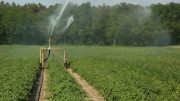|
Click to listen to this article
|
By Dale Lathim
This spring has been full of surprises for growers of most crops in the Columbia Basin. Prices for most crops are down substantially from where they were last year, and many crops that contract their volume are also greatly reduced. However, one thing that is not a surprise is how stable the potato contract prices are for 2024.
This point was driven home to me recently in two different ways. First, I was preparing for an upcoming presentation, and I used a graph depicting the annual contract returns at all three major processors in the Basin compared to the fresh price received each year by local growers. The line for contract pricing was very steadily increasing as the contract price kept up with the rate of inflation in the growing economic environment. Of course, there was a bump in price for the 2022 crop year as growers experienced hyperinflation. Even with the bump in the line for 2022, the graph looked very stable.
The fresh price during the 10 years I was looking at, however, was all over the place – from being well below the price we received on our contracts to more than triple the contract price in 2022. However, the sad part is that the price was lower than the contract price for more years than it was above the line. Further, as we all know, price is a product of supply and demand. The higher prices get, the shorter the supply and fewer growers/shippers get to experience those prices or only get to ship a limited volume. Conversely, when prices are low, that usually means there is an oversupply and everyone in the fresh market feels the pain on a larger portion of their crop.
The second time I was reminded of the stability of contract pricing was when I received a call from one of my favorite growers. He called to tell me that when we first reached our agreement for a low single-digit decrease in contract price for 2024, he was “really pissed off” because he believed we should have gotten at least a rollover in price. However, since then, he has found out the prices on the rest of the crops he plans to grow for 2024, and they are all down well more in both price and volume than he is on his potato contracts. His exact words were, now the potato contracts that I thought were bad are the “shining star” on my farm.
This is a perfect year for everyone to see exactly what we are trying to do with your contract prices. We are trying to keep them as stable as possible and in line with your cost of production. By keeping them at a stable rate of return, we allow you to plan for your future while making a very solid return most years. This also allows for your processors to make long-term business decisions knowing they can count on the price of potatoes, which is still their single biggest cost factor, to remain steady in line with inflation. This is one of the reasons why in the past 20 years, more than 80 percent of the new processing capacity in North America has been in the Columbia Basin. This appears to be continuing as there is a very large expansion under construction in Moses Lake, Washington, right now, and other processing companies are “kicking the tires” on locating additional capacity in the area.
Stable contract pricing may be boring coffee shop talk, but it is the financial engine that runs many of the big farms in the Basin. This only comes about with a very strong grower organization. As you noticed this year, other crops that are contracted certainly didn’t have stable pricing; in fact, sweet corn is not much higher in price this year than it was 20 years ago. Yet it is covered by the same bargaining laws in the state of Washington as frozen potato processors. Potato Growers of Washington has been here for you for many years, and we plan to be here for you for many more. To all of you who are members, we thank you for your support. To all that are not members, we must ask, “why aren’t you?” We welcome all who would like to be part of making each year better for all potato growers.




